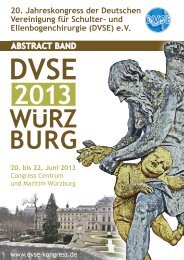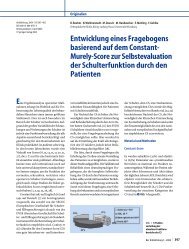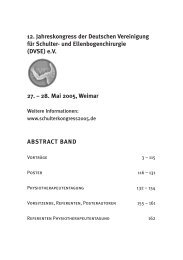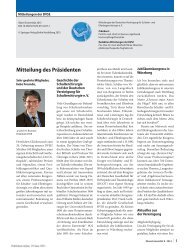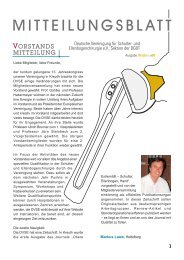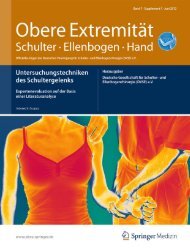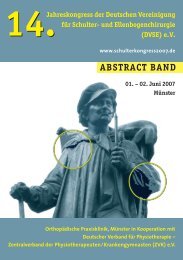Untersuchungstechniken des Schultergelenks - DVSE
Untersuchungstechniken des Schultergelenks - DVSE
Untersuchungstechniken des Schultergelenks - DVSE
Erfolgreiche ePaper selbst erstellen
Machen Sie aus Ihren PDF Publikationen ein blätterbares Flipbook mit unserer einzigartigen Google optimierten e-Paper Software.
Empfehlungen<br />
2.7 Kim-Test<br />
Beschreibung<br />
Der Kim-Test dient der Untersuchung der<br />
dorsalen Labrum- und Kapselstrukturen<br />
(. Tab. 11).<br />
Erstbeschreibung durch Kim et al.<br />
(2005). „The Kim test was performed<br />
with the patient in a sitting position with<br />
the arm in 90° of abduction. With the examiner<br />
holding the patient’s elbow and lateral<br />
aspect of the proximal arm, a simultaneous<br />
axial loading force and 45° upward<br />
diagonal elevation was applied to the distal<br />
arm (. Abb. 31a), while inferior and<br />
posterior force was applied to the proximal<br />
arm (. Abb. 31b). A sudden onset of<br />
posterior shoulder pain was considered a<br />
positive test result, regardless of accompanying<br />
posterior clunk of the humeral head.<br />
Dur ing the test, it was important to apply<br />
a firm axial compression force to the glenoid<br />
surface by the humeral head. There fore,<br />
having the patient sit against the back of<br />
Abb. 31 8 a, b Durchführung <strong>des</strong> Kim-Tests. (Mod. nach [1])<br />
Tab. 11 Kim-Test<br />
Autor<br />
Kim et al.<br />
(2005)<br />
Struktur Sensitivität<br />
(%)<br />
Interoberserver-Reliabilität 0,91<br />
30 | Obere Extremität Supplement 1 · 2012<br />
a chair rather than on a stool or with an<br />
assistant stabilizing the patient provi<strong>des</strong> a<br />
good countersupport of the axial loading in<br />
the examining arm.”<br />
Untersuchungstechnik<br />
Der Patient wird in sitzend positioniert.<br />
Der Arm wir in 90° Abduktion bewegt,<br />
wobei der Untersucher den Ellbogen mit<br />
der einen Hand und das mittlere Drittel<br />
<strong>des</strong> Oberarms mit der anderen Hand fest<br />
umgreift.<br />
Der Arm wird von distal über den Ellbogen<br />
axial in die Schulter gestaucht. Dabei<br />
wird der Arm 45° diagonal flektiert<br />
wird, wobei der Untersucher eine ab- und<br />
rückwärts gerichtete Kraft auf den proximalen<br />
Oberarm ausübt.<br />
Der Test gilt als positiv, wenn der Patient<br />
einen plötzlich eintretenden hinteren<br />
Schulterschmerz angibt. Zusätzlich<br />
kann ein hinteres „Klacken“ <strong>des</strong> Humeruskopfes<br />
als positiver Test gewertet<br />
werden.<br />
Spezifität<br />
(%)<br />
PPV NPV<br />
80 94 0,73 0,96<br />
Literatur<br />
1. Kim SH, Park JS, Jeong WK, Shin SK (2005) The Kim<br />
test: A novel test for posteroinferior labral lesion of<br />
the shoulder − a comparison to the Jerk test. Am J<br />
Sports Med 33: 1188−1192



